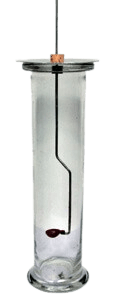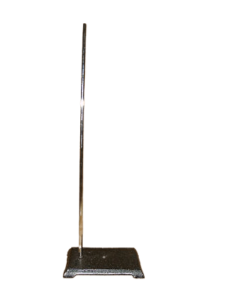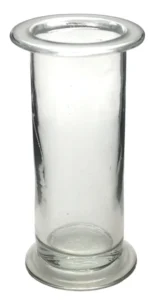A deflagrating spoon is a long metallic spoon with a vertical handle that is often used in the laboratory to hold substances that are being burned in gas jars.
As you can see in the picture below, it typically consists of a long handle with a small cup at the end to hold the sample to be burnt.

The handle is designed to be long to keep the hands of the person doing the experiment away from the substance being burnt. This is important for two reasons:
- To reduce the risk of accidents
- To allow for controlled combustion
Most deflagrating spoons come with a top cover which allows it to be placed in a gas jar as shown below.

As you might have guessed, the cover serves as a protective cap to prevent any spills or splashes from the burning substance from escaping the container, reducing the risk of accidents during the experiment.
Experiments That Require the Use a Deflagrating Spoon
You might be curious about the experiments that would need a deflagrating spoon. Well, typically, it’s used for experiments involving burning highly reactive elements. Highly reactive elements like phosphorus and sulfur can ignite spontaneously when exposed to air.
A deflagrating spoon is used to safely burn such elements at a distance. It also makes it easy for the person doing the experiment to demonstrate the reactivity and properties of such elements at a safe distance.
Safety Tips When Using a Deflagrating Spoon
When using a deflagrating spoon in experiments, it is essential to follow safety tips to ensure a safe and controlled environment.
Some of the most important safety tips to remember when using a deflagrating spoon include:
- Wear appropriate protective gear: Always wear safety goggles, gloves, and a lab coat to protect yourself from any potential splashes or spills.
- Handle with care: Use the long handle of the spoon to keep your hands away from the heat source and the burning substance to prevent burns or injuries.
- Avoid direct contact: Do not touch the heated spoon or the burning substance directly to prevent accidental burns or exposure to hazardous materials.
- Use in a well-ventilated area: Conduct experiments in fume cupboards or a well-ventilated area to ensure proper airflow and reduce exposure to fumes or smoke produced during combustion.
- Proper disposal: Dispose of any leftover materials or residues safely according to laboratory guidelines to prevent accidents or environmental hazards.
Apart from these safety tips, strive to adhere to all other laboratory safety rules. Check this post for a quick overview of the basic lab safety rules for students.



